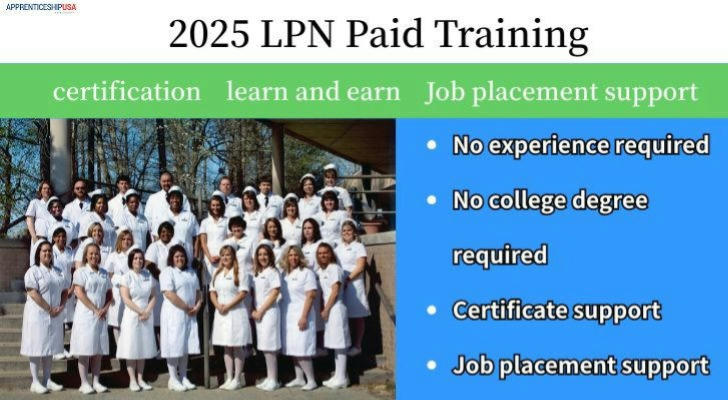Government-Supported LPN Programs: A Fast, Affordable Path to a Career in Healthcare
Are you looking for a stable, well-paying job in the healthcare field — without spending years in school or taking on heavy student debt? Government-supported Licensed Practical Nurse (LPN) programs offer a fast and affordable solution for those who want to start a meaningful career while continuing to earn and support their families.
Whether you're a single parent, a career changer, a veteran, or someone seeking a reliable future in a high-demand industry, these LPN programs could be your first step toward a rewarding healthcare career.

🌟 Why Choose an LPN Career?
Licensed Practical Nurses play a crucial role in hospitals, clinics, long-term care facilities, and home health environments. They work directly with patients under the supervision of Registered Nurses (RNs) and physicians, performing hands-on tasks such as administering medications, checking vital signs, assisting with hygiene, and supporting recovery.
Top reasons to choose the LPN path:
Short-term training: Most programs are completed in 9–12 months.
Good income potential: Starting salaries average $50,000 to $60,000 annually.
Growing demand: The aging population has driven up demand for LPNs nationwide.
Career growth: Bridge to RN later, without starting from scratch.
Fulfilling work: Make a difference in people's lives every day.
💡 What Makes Government-Funded LPN Programs Different?
Unlike traditional nursing schools that can cost tens of thousands of dollars, government-supported LPN programs are designed to remove financial and time barriers so you can train without additional stress.
These programs offer:
✅ Tuition, books, and materials covered by federal or state funds
✅ No additional cost to eligible participants
✅ Flexible online and hybrid learning formats
✅ Paid clinical placements or work-study options
✅ Continued employment while enrolled
✅ Job placement assistance after graduation
✅ No prior experience required — ideal for beginners
Many are part of Workforce Innovation and Opportunity Act (WIOA) programs, designed to help underemployed adults gain in-demand job skills.
👩⚕️ Designed for Beginners
You don’t need a science background or prior healthcare experience. These LPN programs are structured to teach you from the ground up. If you’re worried about returning to school or starting over — don’t be. Thousands of successful graduates began exactly where you are today.
Who these programs are ideal for:
Adults with high school diplomas or GEDs
Parents balancing childcare responsibilities
Veterans transitioning to civilian careers
Workers from retail, food service, or warehouse backgrounds
People with no previous healthcare knowledge
The goal is to make career change accessible, achievable, and worthwhile.
📚 What You’ll Learn
Each government-backed LPN course is approved by your state’s board of nursing and aligned with the NCLEX-PN exam (National Council Licensure Examination – Practical Nurse).
Topics include:
Human anatomy and physiology
Medical terminology
Pharmacology and dosage calculations
Patient care and personal hygiene assistance
Vital signs monitoring and charting
Infection control and safety procedures
Mental health and geriatric nursing
Clinical hands-on training in local facilities
NCLEX-PN test preparation
💵 Learn While You Earn
Worried about losing income while training? Many LPN students continue to work part-time or full-time, thanks to flexible course schedules. Some programs even offer stipends, paid internships, or allow you to work as a CNA (Certified Nursing Assistant) while studying.
This means you don’t have to choose between education and income — you can have both.
🧾 Who Qualifies?
You may be eligible for government-funded LPN programs if you:
Are a U.S. citizen or legal resident
Hold a high school diploma or GED
Are unemployed, underemployed, or receiving SNAP/TANF benefits
Are a veteran, single parent, or displaced worker
Participate in WIOA or a similar workforce program
Eligibility varies by state — your local workforce board or community college can help assess your qualifications.
🎓 Real Stories, Real Success
Lydia, 33, was working in retail with no healthcare background. She found a WIOA-supported LPN program at her local college, completed it in 9 months, and is now earning over $55,000 annually in a nursing home.
James, 39, a military veteran, wanted a civilian career that gave him purpose. With VA and state support, he trained online while working part-time and now serves in a hospital emergency department as a licensed LPN.
✅ What Happens After Graduation?
After completing your coursework and clinicals, you’ll be eligible to sit for the NCLEX-PN exam. Once you pass, you’ll receive your LPN license and can apply for jobs across:
Hospitals and urgent care centers
Nursing homes and assisted living facilities
Doctor’s offices and outpatient clinics
Home healthcare agencies
Schools and public health programs
Job placement services are often included with government-sponsored programs, so you’re not on your own once you graduate.
📌 How to Get Started
Starting your journey is easier than you think:
Persistent efforts
Visit your state workforce office or job center
Check your eligibility for tuition assistance
Enroll in a certified training provider or community college
Begin training while continuing to work or care for your family
🔓 Your Healthcare Career Starts Today
A meaningful, financially stable career in healthcare is within reach — no need for years of schooling or crushing debt. Government-supported LPN programs remove the barriers and offer a fast track to a career that’s respected, recession-resistant, and needed in every community.
If you’re ready to make a change, take the first step today. Visit your local workforce office or training provider, and start your path toward becoming a Licensed Practical Nurse.
